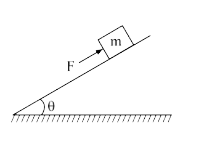A body of mass m is kept on an inclined plane . The force required to just move a body up the inclined plane is double the force required to just prevent the body from sliding down the plane. If the coefficient of friction is μ, what is the inclination of the plane ?
The correct Answer is:tan−13μ
To solve the problem, we need to analyze the forces acting on the body on the inclined plane and use the information given in the question.
1. Identify the Forces:
- The weight of the body W=mg acts vertically downward.
- The component of weight acting parallel to the incline is W∥=mgsinθ.
- The component of weight acting perpendicular to the incline is W_{\perpendicular} = mg \cos \theta .
- The frictional force Ff acting up the incline is F_f = \mu W_{\perpendicular} = \mu mg \cos \theta .
2. Force to Prevent Sliding Down:
- To prevent the body from sliding down, the frictional force must balance the component of weight acting down the incline:
F2=mgsinθ−μmgcosθ
Here, F2 is the force required to just prevent the body from sliding down.
3. Force to Move Up the Incline:
- The force required to just move the body up the incline is given as double that required to prevent sliding down:
F1=2F2
Substituting for F2:
F1=2(mgsinθ−μmgcosθ)
4. Force Balance for Moving Up:
- The force required to move the body up the incline must overcome both the component of weight acting down the incline and the frictional force:
F1=mgsinθ+μmgcosθ
5. Setting the Two Expressions for F1 Equal:
- We now have two expressions for F1:
2(mgsinθ−μmgcosθ)=mgsinθ+μmgcosθ
Simplifying this equation:
2mgsinθ−2μmgcosθ=mgsinθ+μmgcosθ
Rearranging gives:
2mgsinθ−mgsinθ=2μmgcosθ+μmgcosθ
mgsinθ=3μmgcosθ
6. Canceling mg:
- Since mg is common on both sides, we can cancel it out (assuming m≠0):
sinθ=3μcosθ
7. Dividing by cosθ:
- Dividing both sides by cosθ:
tanθ=3μ
8. Finding the Angle:
- The inclination θ can be expressed as:
θ=tan−1(3μ)
Final Answer:
The inclination of the plane is given by:
θ=tan−1(3μ)
- The weight of the body W=mg acts vertically downward.
- The component of weight acting parallel to the incline is W∥=mgsinθ.
- The component of weight acting perpendicular to the incline is W_{\perpendicular} = mg \cos \theta .
- The frictional force Ff acting up the incline is F_f = \mu W_{\perpendicular} = \mu mg \cos \theta .
- To prevent the body from sliding down, the frictional force must balance the component of weight acting down the incline:
F2=mgsinθ−μmgcosθ
Here, F2 is the force required to just prevent the body from sliding down.
- The force required to just move the body up the incline is given as double that required to prevent sliding down:
F1=2F2
Substituting for F2:
F1=2(mgsinθ−μmgcosθ)
- The force required to move the body up the incline must overcome both the component of weight acting down the incline and the frictional force:
F1=mgsinθ+μmgcosθ
- We now have two expressions for F1:
2(mgsinθ−μmgcosθ)=mgsinθ+μmgcosθ
Simplifying this equation:
2mgsinθ−2μmgcosθ=mgsinθ+μmgcosθ
Rearranging gives:
2mgsinθ−mgsinθ=2μmgcosθ+μmgcosθ
mgsinθ=3μmgcosθ
- Since mg is common on both sides, we can cancel it out (assuming m≠0):
sinθ=3μcosθ
- Dividing both sides by cosθ:
tanθ=3μ
- The inclination θ can be expressed as:
θ=tan−1(3μ)
The inclination of the plane is given by:
θ=tan−1(3μ)
Topper's Solved these Questions
Similar Questions
The force F1 required to just moving a body up an inclined plane is double the force F2 required to just prevent the body from sliding down the plane. The coefficient of friction is μ. The inclination θ of the plane is :
View SolutionThe force required to just move a body up the inclined plane is double the force required to just prevent the body from sliding down the plane. The coefficient of friction is μ. If θ is the angle of inclination of the plane than tanθ is equal to
View SolutionThe force required just to move a body up an inclined plane is double the force required just to prevent the body sliding down. If the coefficient of friction is 0.25, what is the angle of inclination of the plane ?
View SolutionThe force required to move a body up a rough inclined plane is double the force required to prevent the body from sliding down the plane. The coefficient of friction when the angle of inclination of the plane is 60∘ is .
View SolutionIn the situation shown, the force required to just move a body up an inclined plane is double the force required to just prevent the body from sliding down the plane. The coefficient of friction between the block and plane is μ. The angle of inclination of the plane from horizontal is given by :

View SolutionThe minimum force required to move a body up an inclined plane is three times the minimum force required to prevent it from sliding down the plane. If the coefficient of friction between the body and the inclined plane is 12√3, the angle of the inclined plane is
View SolutionWhen a body slides down an inclined plane with coefficient of friction as μk, then its acceleration is given by .
View SolutionA body of mass 8kg is in limiting equilibrium over an inclined plane of inclination 30∘. If the inclination is made 60∘, the minimum force required to prevent the body from sliding down is (g=10ms−2)
View SolutionA block of mass m is lying on an inclined plane. The coefficient of friction between the plane and the block is μ. The force (F1) required to move the block up the inclined plane will be:-
View SolutionA block is moving on an inclined plane making an angle 45∘ with the horizontal and the coefficient of friction is μ. The force required to just push it up the inclined plane is 3 times the force required to just prevent it from sliding down. If we define N=10μ, then N is
View Solution
